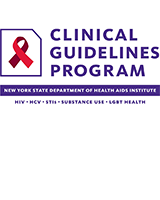New York State Department of Health AIDS Institute Clinical Guidelines
About the AIDS Institute Clinical Guidelines Program
Developer: New York State Department of Health AIDS Institute (NYSDOH AI) Clinical Guidelines Program
Funding Source: NYSDOH AI
Program Manager: Clinical Guidelines Program, Johns Hopkins University School of Medicine, Division of Infectious Diseases. See Program Leadership and Staff.
Mission: To produce and disseminate evidence-based, state-of-the-art clinical practice guidelines that establish uniform standards of care for practitioners who provide prevention or treatment of HIV, viral hepatitis, other sexually transmitted infections, and substance use disorders for adults throughout New York State in the wide array of settings in which those services are delivered.
Expert Committees: The NYSDOH AI Medical Director invites and appoints committees of clinical and public health experts from throughout NYS to ensure that the guidelines are practical, immediately applicable, and meet the needs of care providers and stakeholders in all major regions of NYS, all relevant clinical practice settings, key NYS agencies, and community service organizations.
Committee Structure:
- Leadership: AI-appointed chair, vice chair(s), chair emeritus, clinical specialist(s), JHU Guidelines Program Director, AI Medical Director, AI Clinical Consultant, AVAC community advisor
- Contributing members
- Guideline writing groups: Lead author, coauthors if applicable, and all committee leaders
Disclosure and Management of Conflicts of Interest:
- Annual disclosure of financial relationships with commercial entities for the 12 months prior and upcoming is required of all individuals who work with the guidelines program, and includes disclosure for partners or spouses and primary professional affiliation.
- The NYSDOH AI assesses all reported financial relationships to determine the potential for undue influence on guideline recommendations and, when indicated, denies participation in the program or formulates a plan to manage potential conflicts. Disclosures are listed for each committee member.
Evidence Collection and Review:
- Literature search and review strategy is defined by the guideline lead author based on the defined scope of a new guideline or update.
- A comprehensive literature search and review is conducted for a new guideline or an extensive update using PubMed, other pertinent databases of peer-reviewed literature, and relevant conference abstracts to establish the evidence base for guideline recommendations.
- A targeted search and review to identify recently published evidence is conducted for guidelines published within the previous 3 years.
- Title, abstract, and article reviews are performed by the lead author. The JHU editorial team collates evidence and creates and maintains an evidence table for each guideline.
Recommendation Development:
- The lead author drafts recommendations to address the defined scope of the guideline based on available published data.
- Writing group members review the draft recommendations and evidence and deliberate to revise, refine, and reach consensus on all recommendations.
- When published data are not available, support for a recommendation may be based on the committee’s expert opinion.
- The writing group assigns a 2-part rating to each recommendation to indicate the strength of the recommendation and quality of the supporting evidence. The group reviews the evidence, deliberates, and may revise recommendations when required to reach consensus.
Review and Approval Process:
- Following writing group approval, draft guidelines are reviewed by all contributors, program liaisons, and a volunteer reviewer from the AI Community Advisory Committee.
- Recommendations must be approved by two-thirds of the full committee. If necessary to achieve consensus, the full committee is invited to deliberate, review the evidence, and revise recommendations.
- Final approval by the committee chair and the NYSDOH AI Medical Director is required for publication.
External Reviewers:
- External review of each guideline is invited at the developer’s discretion.
- External reviewers recognized for their experience and expertise review guidelines for accuracy, balance, clarity, and practicality and provide feedback.
Update Process:
- JHU editorial staff ensure that each guideline is reviewed and determined to be current upon the 3-year anniversary of publication; guidelines that provide clinical recommendations in rapidly changing areas of practice may be reviewed annually. Published literature is surveilled to identify new evidence that may prompt changes to existing recommendations or development of new recommendations.
- If changes in the standard of care, newly published studies, new drug approval, new drug-related warning, or a public health emergency indicate the need for immediate change to published guidelines, committee leadership will make recommendations and immediate updates and will invite full committee review as indicated.
Recommendation Ratings and Definitions: Each recommendation receives a 2-part rating for strength and quality of evidence (e.g., A1, B1, A2†, etc.).
Strength is rated as follows:
A—Strong
B—Moderate
C—Optional
Quality of evidence is rated as follows:
1—Based on published results of at least 1 randomized clinical trial with clinical outcomes or validated laboratory endpoints.
*—Based on either a self-evident conclusion; conclusive, published, in vitro data; or well-established practice that cannot be tested because ethics would preclude a clinical trial.
2—Based on published results of at least 1 well-designed, nonrandomized clinical trial or observational cohort study with long-term clinical outcomes.
2†—Extrapolated from published results of well-designed studies (including nonrandomized clinical trials) conducted in populations other than those specifically addressed by a recommendation. The source(s) of the extrapolated evidence and the rationale for the extrapolation are provided in the guideline text. One example would be results of studies conducted predominantly in a subpopulation (e.g., one gender) that the committee determines to be generalizable to the population under consideration in the guideline.
3—Based on committee expert opinion, with rationale provided in the guideline text.
Shared Decision-Making: Throughout its guidelines, the NYSDOH AI Clinical Guidelines Program recommends “shared decision-making,” an individualized process central to patient-centered care. With shared decision-making, clinicians and patients engage in meaningful dialogue to arrive at an informed, collaborative decision about a patient’s health, care, and treatment planning. See Clinical Guidelines Program Approach to Shared Decision-Making.
This book is licensed under the terms of the Attribution-NonCommercial-NoDerivs 3.0 Unported (CC BY-NC-ND 3.0).
